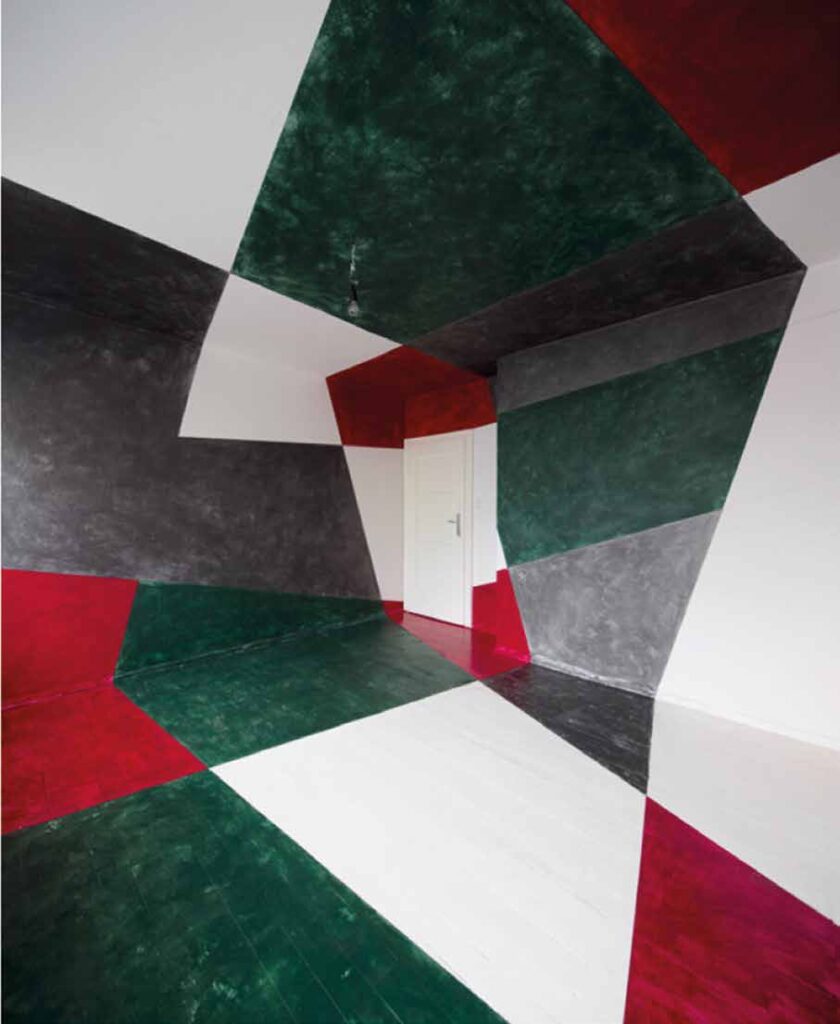Rysunek przestrzenny
Raumzeichnung
Spatial Drawing
Artysta | Künstler |artist: Roland Geissel (1965)
miejsce | Ort | place: Słubicki Miejski Ośrodek Kultury SMOK, ul. 1 Maja 1, Słubice
Od roku 2000 w różnych krajach, w przestrzeniach prywatnych i publicznych, w galeriach, stowarzyszeniach artystycznych i muzeach powstało wiele rysunków przestrzennych. Rysunek przestrzenny to przestrzeń architektoniczna, która za pomocą malarstwa i systemu rastrowego została przekształcona w dzieło sztuki. Kategorie architektoniczne, które przypisują podłodze inną funkcję niż ścianie czy sufitowi, zostają w tym przypadku przełamane, a wymienione płaszczyzny – potraktowane równorzędnie. Rysunki przestrzenne niczego nie udają, nie tworzą iluzji, są w sensie sztuki konkretnej „jedynie” tym, co widz ma przed oczami. Choć przestrzeń rysunku przestrzennego jest pusta, to nie wydaje się pusta, a wszystko, co nie jest w niej zamalowane, a więc niepodporządkowane systemowi rastrowemu, jak drzwi, włączniki i kontakty, lampy czy piece kaflowe, zyskuje nagle wyjątkowe znaczenie. W dwóch miejscach rozciągnąłem i przykleiłem płótno do podłogi. Płótno, które w muzeach i galeriach zazwyczaj wisi na ścianie, w tym wypadku stało się podłogą. Odwiedzający musiał więc wejść w obraz. Spowodowało to znaczne zmiany w postrzeganiu pomieszczenia. Architektura wydaje się wizualnie znikać za danym rysunkiem przestrzennym
Seit dem Jahr 2000 sind etliche Raumzeichnungen in unterschiedlichen Ländern, in privaten und öffentlichen Räumen, in Galerien, Kunstvereinen und Museen entstanden. Eine Raumzeichnung ist ein architektonischer Raum, der sich mittels Malerei und eines Rastersystems in ein Kunstwerk verwandelt hat. Die gesetzmäßige Zuordnung der Architektur, welche dem Fußboden eine andere Funktion zuschreibt als der Wand oder der Decke wird hier aufgebrochen und gleichbehandelt. Die Raumzeichnungen täuschen nichts vor, sie erzeugen keine Illusion, sondern sind im Sinne der konkreten Kunst „nur“ das, was der Betrachter vor Augen hat. Obwohl der Raum der Raumzeichnung leer ist, wirkt er nicht leer und alles was nicht bemalt ist und damit dem Rastersystem nicht untergeordnet ist, wie Türen, Schalter und Steckdosen, Lampen oder Kachelofen, bekommen plötzlich eine besondere Aufmerksamkeit. An zwei Orten hatte ich eine Leinwand auf dem Fussboden verspannt und geleimt. Die Leinwand, die normalerweise in Museen und Galerien an der Wand hängt, war in diesem Fall der Fussboden. Der Besucher der Raumzeichnung musste in ein Bild eintreten. Dies ergab für die Wahrnehmung des Raumes erhebliche Veränderungen. Es scheint die Architektur hinter der Raumzeichnung visuell zu verschwinden
Since 2000, a large number of spatial drawings have been created in various countries, in private and public spaces, galleries, art associations and museums. A spatial drawing is an architectural space that has been transformed into a work of art by means of painting and the raster system. The architectural categories, which ascribe a different function to the floor than to the wall or ceiling, are in this case broken down and the mentioned planes are treated equally. Spatial drawings do not pretend to do anything, they do not create an illusion; they are, in the sense of concrete art, “merely” what the viewers have before their eyes. Although the space of the spatial drawing is empty, it does not appear empty, and everything that is not painted in it and therefore not subject to the raster system (such as doors, switches and contacts, lamps or tiled cookers), suddenly acquires a unique meaning. In two places I stretched canvas over and glued it to the floor. The canvas, which in museums and galleries usually hangs on the wall, in this case became the floor. The visitors therefore had to step into the painting. This caused a significant change in the perception of the room. The architecture seems to have visually disappeared behind this spatial drawing.
